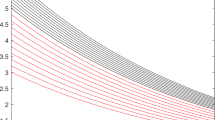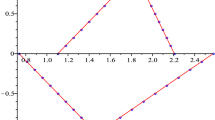Abstract
Several problems in the field of science and technology are modeled with information about the situation that is ambiguous, imprecise, or incomplete. That is, the information about values of parameters, functional relationships, or initial conditions is not given in precise. In these circumstance, existing analytic or numerical methods can be applied only to the selected behavior of the system. For example, by fixing the values of unknown parameters to some credible values. On the basis of partial knowledge, it is impossible to describe the behavior of complete system. Thus, fuzzy differential equations arise in many dynamical models. In modeling of several real-world problems, differential equations frequently involve multi-agent, multi-index, multi-objective, multi-attribute, multi-polar information or uncertainty rather than a single bit. These type of differential equations cannot be well represented by means of fuzzy differential equations or bipolar fuzzy differential equations. Therefore, the theory of m-polar fuzzy sets can be applied to differential equations to handle the problems which have multi-polar information. The aim of this paper is to study differential equation in m-polar fuzzy environment. A fourth-order Runge–Kutta method to solve m-polar FIVPs is presented. The consistency, stability and convergence of suggested method are discussed to ensure its efficiency and validity. Since it requires no higher order function derivatives, the suggested method is straightforward to implement. Euler and Euler modified methods have global truncations errors of O(h) and \(O(h^{2})\) respectively whereas the suggested Runge–Kutta’s global truncation errors of \(O(h^{4})\). Numerical examples are provided to compare the proposed method with Euler and modified Euler methods in terms of global truncation errors (GTE). The numerical findings suggest that the purposed method has an adequate level of accuracy.


















Similar content being viewed by others
Data availability
No data were used to support this study.
References
Abbasbandy S, Allahviranloo T (2002) Numerical solutions of fuzzy differential equations by Taylor method. J Comput Methods Appl Math 2:113–124
Ahmady N, Allahviranloo T, Ahmady E (2020) A modified Euler method for solving fuzzy differential equations under generalized differentiability. Comput Appl Math 39(2):1–21
Akram M (2019) \(m\)-Polar fuzzy graphs. Stud Fuzziness Soft Comput 371:1–296
Akram M, Shahzadi G (2017) Certain characterization of \(m\)-polar fuzzy graphs by level graphs. Punjab Univ J Math 49(1):1–12
Akram M, Saleem D, Allahviranloo T (2019) Linear system of equations in \(m\)-polar fuzzy environment. J Intell Fuzzy Syst 37(6):8251–8266
Allahviranloo T (2020) Fuzzy fractional operators and equations. Springer, Berlin
Allahviranloo T, Pedrycz W (2020) Soft numerical computing in uncertain dynamical systems. Elsevier, Amsterdam
Allahviranloo T, Gouyandeh Z, Armand A (2015) A full fuzzy method for solving differential equation based on Taylor expansion. J Intell Fuzzy Syst 29:1039–1055
Anastassiou GA (1971) Numerical initial value problems in ordinary differential equations. Prentice Hall, Englewood Clifs
Arman A, Allahviranloo T, Abbasbandy S, Gouyandeh Z (2019) The fuzzy generalized Taylor’s expansion with application in fractional differential equations. Iran J Fuzzy Syst 16(2):55–72
Armand A, Allahviranloo T, Gouyandeh Z (2018) Some fundamental results of fuzzy calculus. Iran J Fuzzy Syst 15(3):27–46
Atanassov KT (1999) Intuitionistic fuzzy sets. In: Intuitionistic fuzzy sets, pp 1–324
Bede B (2008) Note on “Numerical solutions of fuzzy differential equations by predictor-corrector method’’. Inf Sci 178:1917–1922
Bede B (2013) Fuzzy differential equations. Stud Fuzziness Soft Comput 295:171–191
Bede B, Gal SG (2005) Generalization of the differentiability of fuzzy number valued function with application to fuzzy differential equations. Fuzzy Sets Syst 151:581–599
Bede B, Stefanini L (2013) Generalized differentiability of fuzzy-valued functions. Fuzzy Sets Syst 230:119–141
Bede B, Rudas IJ, Bencsik AL (2007) First order linear fuzzy differential equations under generalized differentiability. Inf Sci 177:1648–1662
Behzadi SS, Allahviranloo T (2016) Solving fuzzy differential equations by using Picard method. Iran J Fuzzy Syst 13(3):71–81
Cano YC, Flores MS (2008) On new solutions of fuzzy differential equations. IEEE Trans Syst Man Cybern Part B Cybern 38(1):112–119
Cano YC, Flores RH, Jimenez-Gamero MD (2011) Generalized derivative and \(\pi \)-derivative for set-valued functions. Inf Sci 181:2177–2188
Chang SSL, Zadeh LA (1972) On fuzzy mapping and control. IEEE Trans Syst Man Cybern 2:30–34
Chen J, Li S, Ma S, Wang S (2014) \(m\)-polar fuzzy sets: an extension of bipolar fuzzy sets. Sci World J. Article ID 416530
Dubois D, Prade H (1982) Towards fuzzy differential calculus III. Fuzzy Sets Syst 8(3):225–233
Effati S, Pakdaman M (2010) Artificial neural network approach for solving fuzzy differential equations. Inf Sci 180:1434–1457
Epperson JF (2007) An introduction to numerical methods and analysis. Wiley, New York
Fard OS, Feuring T (2001) Numerical solutions for linear system of first order fuzzy differential equations. Inf Sci 181:4765–4779
Friedman M, Ma M, Kandel A (1999) Numerical solutions of fuzzy differential and integral equations. Fuzzy Sets Syst 106(1):35–48
Gasilov NA, Fatullayev AA, Amrahov SE, Khastan A (2014) A new approach to fuzzy initial value problem. Soft Comput 18:217–225
Ghazanfari B, Shakerami A (2012) Numerical solution of fuzzy differential equations by extended Runge–Kutta like formulae of order 4. Fuzzy Sets Syst 189:74–91
Guang-Quan Z (1991) Fuzzy continuous function and its properties. Fuzzy Sets Syst 43(2):159–171
Ivaz K, Khastan A, Neito JJ (2013) A numerical method for fuzzy differential equations and hybrid fuzzy differential equations. Abstr Appl Anal 10:1–10
Jayakumar T, Kanagarajan K, Indrakumar S (2012) Numerical solution of nth-order fuzzy differential equation by Runge–Kutta method of order five. Int J Math Anal 6:2885–2896
Kaleva O (1987) Fuzzy differential equations. Fuzzy Sets Syst 24:301–317
Koam ANA, Akram M, Muhammad G, Hussain N (2020) LU decomposition scheme for solving \(m\)-polar fuzzy system of linear equations. Math Probl Eng. Article ID 8384593
Liu XM, Jiang J, Hong L (2021) A numerical method to solve a fuzzy differential equation via differential inclusions. Fuzzy Sets Syst 404:38–61
Ma M, Friedman M, Kandel M (1999) Numerical solutions of fuzzy differential equations. Fuzzy Sets Syst 105:133–138
Mondal SP, Roy TK (2013) First order linear nonhomogeneous ordinary differential equation in fuzzy environment. Math Theory Model 3:85–95
Nieto JJ (1999) The Cauchy problem for continuous differential equations. Fuzzy Sets Syst 102:259–262
Nieto JJ, Khastan A, Ivaz K (2009) Numerical solution of fuzzy differential equations under generalized differentiability. Nonlinear Anal Hybrid Syst 3(4):700–707
Palligkinis S, Papageorgious G, Famelis I (2009) Runge–Kutta method for fuzzy differential equations. Appl Math Comput 209:97–105
Parandin N (2011) Numerical solution of fuzzy differential equations of nth order by Runge–Kutta method. Neural Comput Appl 181:4765–4779
Pederson S, Sambandham M (2008) The Runge–Kutta method for hybrid fuzzy differential equations. Nonlinear Anal Hybrid Syst 2:626–634
Pederson S, Sambandham M (2009) Numerical solution of hybrid fuzzy differential equation IVPs by a characterization theorem. Inf Sci 179:319–328
Rabiei F, Ismail F, Ahmadian A, Salahshour S (2013) Numerical solution of second order fuzzy differential equation using improved Runge–Kutta Nystrom method. Math Probl Eng. Article ID 803462
Saqib M, Akram M, Bashir S, Allahviranloo T (2021) Numerical solution of bipolar fuzzy initial value problem. J Intell Fuzzy Syst 40(1):1309–1341
Saqib M, Akram M, Bashir S, Allahviranloo T (2022) Numerical methods for \(m\)-polar fuzzy initial value problems. Comput Methods Differ Equ
Saqib M, Akram M, Bashir S et al (2021) A Runge–Kutta numerical method to approximate the solution of bipolar fuzzy initial value problems. Comp. Appl. Math. 40:151
Seikkala S (1987) On the fuzzy initial value problem. Fuzzy Sets Syst 24(3):319–330
Stefanini L, Bede B (2009) Generalized Hukuhara differentiability of interval-valued functions and interval differential equations. Nonlinear Anal 71:1311–1328
Tapaswini S, Chakraverty S (2012) A new approach to fuzzy initial value problem by improved Euler method. Fuzzy Inf Eng 4(3):293–312
Wu C, Gong Z (2001) On Henstock integral of fuzzy number valued functions. Fuzzy Sets Syst 120:523–532
Yager RR (2013a) Pythagorean fuzzy subsets. In: Proceedings of joint IFSA World Congress and NAFIPS annual meeting, pp 57–61
Yager RR (2013b) Pythagorean membership grades in multicriteria decision making. IEEE Trans Fuzzy Syst 223(4):958–965
Zadeh LA (1965) Fuzzy sets. Inf Control 8:338–353
Author information
Authors and Affiliations
Corresponding author
Ethics declarations
Ethical approval
This article does not contain any studies with human participants or animals performed by any of the authors.
Additional information
Communicated by Graçaliz Pereira Dimuro.
Publisher's Note
Springer Nature remains neutral with regard to jurisdictional claims in published maps and institutional affiliations.
Rights and permissions
About this article
Cite this article
Akram, M., Saqib, M., Bashir, S. et al. An efficient numerical method for solving m-polar fuzzy initial value problems. Comp. Appl. Math. 41, 157 (2022). https://doi.org/10.1007/s40314-022-01841-2
Received:
Revised:
Accepted:
Published:
DOI: https://doi.org/10.1007/s40314-022-01841-2




